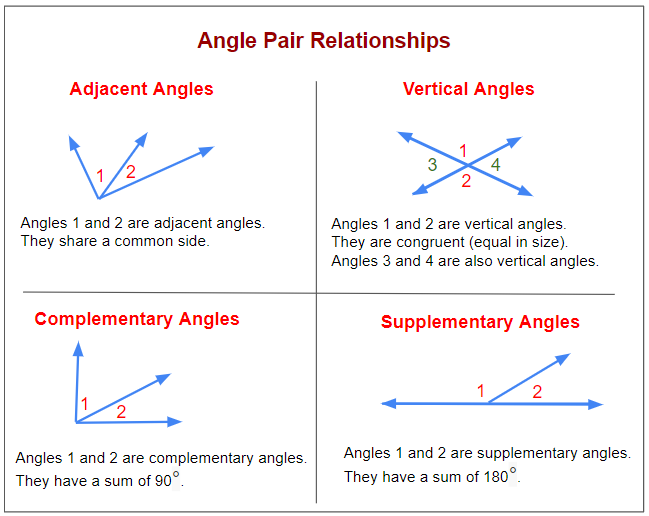Finding Angles
Related Topics:
Common Core for Grade 7
Common Core for Mathematics
Lesson Plans and Worksheets for all Grades
More Lessons for Grade 7
Examples, solutions, worksheets, videos, and lessons to help Grade 7 students learn how to use facts about supplementary, complementary, vertical, and adjacent angles in a multi-step problem to write and solve simple equations for an unknown angle in a figure.
Common Core: 7.G.5
Suggested Learning Targets
- I can recognize and identify types of angles such as supplementary, complimentary, vertical, and adjacent.
- I can use facts about angle relationships (supplementary, complimentary, vertical, and adjacent) to determine the measure of unknown angles.
- I can use facts about angle relationships (supplementary, complimentary, vertical, and adjacent) to solve simple equations.
The following diagram shows some examples of angle pair relationships: adjacent, complementary, supplementary and vertical angles. Scroll down the page for more examples and solutions.

Use supplementary, complementary, vertical, and adjacent angles to find unknown angles (7.G.5)
7.G.5 Adjacent & Vertical Angles
Adjacent angles: angles that share a common side and have the same vertex.
Vertical angles: opposite angles formed by the intersection of 2 lines. They are congruent angles.
Congruent angles; Angles that have the same measure.
Examples:
- Name a pair of adjacent angles.
- Name a pair of vertical angles.
- Tell whether the angles are adjacent or vertical. Then find the value of x.
- Draw a pair of vertical angles with a measure of 40°.
7.G.5 Complementary & Supplementary Angles
Complementary angles: 2 angles whose sum is 90 degrees.
Supplementary angles: 2 angles whose sum is 180 degrees.
Examples:
- Tell whether the angles are complementary, supplementary, or neither.
- Tell whether the angles are complementary or supplementary. Then find the value of x.
- Draw a pair of adjacent supplementary angles so that one angle has a measure of 60°.
Special Angles
This video explains complementary, supplementary, and vertical angles.
Complementary, Supplementary, and Vertical Angles
Angle Relationships 1 (7.G.5)
Complementary angles are angles that form a right angle (add to 90°).
Supplementary angles are angles that form a straight line (add to 180°).
When 2 lines cross to form 4 angles, the angles opposite from each other are vertical angles (and have equal measures).
Try the free Mathway calculator and
problem solver below to practice various math topics. Try the given examples, or type in your own
problem and check your answer with the step-by-step explanations.

We welcome your feedback, comments and questions about this site or page. Please submit your feedback or enquiries via our Feedback page.